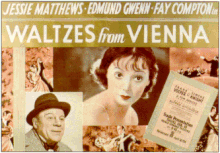Waltzes from Vienna
| Waltzes from Vienna | |
|---|---|

Theatrical release poster
|
|
| Directed by | Alfred Hitchcock |
| Produced by | Tom Arnold |
| Written by |
Guy Bolton Alma Reville A. M. Willner Heinz Reichart Ernst Marischka Claude Allain |
| Starring |
Esmond Knight Jessie Matthews Edmund Gwenn Fay Compton Frank Vosper |
| Music by |
Louis Levy Hubert Bath Erich Wolfgang Korngold Julius Bittner |
|
Production
company |
Gaumont British
Tom Arnold Films |
| Distributed by | Gaumont British |
|
Release date
|
March 1934 (UK) 7 April 1935 (US) |
|
Running time
|
80 min. |
| Country | United Kingdom |
| Language | English |
Waltzes from Vienna is a 1934 British musical film directed by Alfred Hitchcock, also known as Strauss' Great Waltz. It was part of the cycle of operetta films made in Britain during the 1930s.
Hitchcock’s film is based on the stage musical, Waltzes from Vienna, which premiered in Vienna in October 1930. With a libretto by A. M. Willner, Heinz Reichart, and Ernst Marischka, this stage production contains music by Johann Strauss I and Johann Strauss II, selected and arranged by Erich Wolfgang Korngold and Julius Bittner into discrete musical numbers. Hitchcock, however, did not include these musical numbers in his film. In addition, he changed the end of the story. In the stage musical, Resi, the baker’s daughter, decides that her father’s apprentice, Leopold, will make a more suitable husband than the composer, Schani (Johann Strauss II). By contrast, Hitchcock’s film rendition ends with Resi and Schani declaring their love for each other.
The film tells the story of the writing and performance of The Blue Danube. According to Hitchcock:
Waltzes from Vienna gave me many opportunities for working out ideas in the relation of film and music. Naturally every cut in the film was worked out on the script before shooting began. But more than that, the musical cuts were worked out too.
Hitchcock told François Truffaut that this film was the lowest ebb of his career. He only agreed to make it because he had no other film projects that year, and wanted to stay working. He never again made a musical film.
The comment to Truffaut mentioned above has not prevented film scholars from trying to find value in this unusual Hitchcock film, as they point to Waltzes from Vienna as the foundation for many revolutionary ideas that appeared in his more highly regarded films. For example, Jack Sullivan and David Schroeder both agree that Hitchcock used this film to explore the potential of the waltz, which he used as a musical device that carried sinister meaning or accompanied dangerous situations in films like The Lodger (1927), Shadow of a Doubt (1943), Strangers on a Train (1951), and Torn Curtain (1966). Schroeder also suggests that Waltzes from Vienna taught Hitchcock that "gradually building towards a familiar tune, from a murky beginning to the melody known to everyone, will have little dramatic effect" – an experiment that likely remained on his mind as he built the unfamiliar "Lisa" tune out of nothing in Rear Window (1954).
...
Wikipedia
